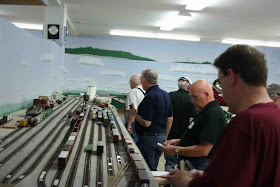Continuing my development of the company "villages" located along the sidings of the Cascade Line, I turned to train order operator housing. During the era of Timetable and Train Order operations on the Cascade Line, the train order stations were continuously staffed. Since those sidings were quite remote, the railroad needed to supply suitable housing for the three shifts of operators at each train order station.
Once again, my efforts have been blessed by the kits produced by ALW Lines: http://alwlines.com/ Specifically, kits SP22 and SP23 provide train order operator house with either a left (22) or right (23) porch addition. The porches were added just a few years after the original line construction in 1926. The left porch variant serves Wicopee, while the right porches were used at Cascade Summit. I will use left porches at Cruzatte and right porches at McCredie Springs, as well.
Cascade Summit village begins with the train order station and operator houses.
The ALW Lines kits feature laser-cut pieces for walls, roofs and trim, and Tichy plastic castings for the windows and chimneys. My kits came with laser-cut shingle sections for the roofs. Construction of these kits is relatively straight-forward, though I found it useful to modify the assembly sequence a bit. I also encountered an "oops" moment that I will describe below. As with most kits, it is important to read the directions. Even then, one's experience may suggest slightly different assembly order.
During assembly, I found it useful to put the peel and stick door trim onto the door backs before I mounted those assemblies into the walls. Doing so facilitated a small amount of trimming I found I needed to adjust the door height to more easily fit the door jamb hole. This became very important with the side porch outside door, as the door back width needed to be sanded down to better fit the porch width.
My "oops" moment occurred when I started to fit the roof sections onto the assembled structure core. I discovered that I reversed the positions of the two internal roof supports. One of these supports has a different lower profile on the front to support the front porch roof. The difference is subtle, but real. Fortunately, I was able to remove my original mounting with the aid of a razor saw and then remount after a general cleanup of the removed parts and the ceiling/attic base. Since the attic would be closed up when the roof sections were attached, I created simple triangular braces to remount the roof supports perpendicular to the attic base.
Roof Support installation mistake. The supports for the house on the left are correct. The ones on the right are reversed in position. Note the subtly higher right side needed to support the porch roof--correctly located on the left.
Correcting a mistake. The roof supports have been re-mounted in the correct locations. Triangular braces cut from the corners of some the kit frets have been attached to help keep the roof suports vertical and perpendicular to the attic base.
One other significant assembly order alteration was needed. I installed the Tichy windows before attaching the roof sections. The front porch roof seals in that porch. There is a window inside this porch that needed to be installed before the porch roof.
To help indicate this housing is occupied and in use, I added simple roll shades to the windows of the core building. I simply added small bits of paper to the inside of the windows with some height variation. Canopy glue is a very useful adhesive! During initial assembly I added basic interior walls to prevent a see-through effect. These two additions help bring the houses alive.
Two of the operator houses at Cascade Summit. The house on the left has a window blind pulled all the way down. The night shift operator needs his sleep!
I used a craft paint antiquing acrylic to add mortar detail to the chimneys. I brushed the acrylic onto the chimneys and immediately wiped most of it off using a damp paper towel. This left most of the mortar lines defined with a contrasting color (beige against dull brick red).
Cruzatte station village begun.
With two station sets of operator houses built, my company villages are beginning to take shape. Indeed, I will use these structures to lay out the villages, adding terrain definition and foundations based on these completed structures.
















